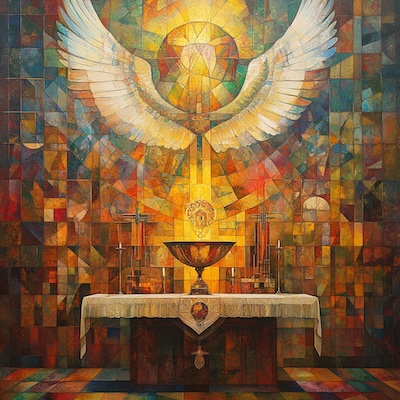The Unexpected Common Ground: Real Presence and Manifest Presence:
Many Catholics and Evangelicals, particularly those in Charismatic traditions, might be surprised to discover how closely their beliefs about the presence of God align, especially regarding the Eucharist (for Catholics) and the concepts of anointing and manifest presence (for Evangelicals). While the terminology and context differ, the core idea – that God’s presence becomes tangibly real in specific moments and places – reveals a significant point of convergence. I invite you to read this article and then make your comments and express your views in the comment section below.
Understanding the Concepts
Catholic Real Presence: The Catholic Church teaches that in the Eucharist, the bread and wine truly become the body and blood of Christ while still retaining the appearance of bread and wine. This is known as transubstantiation. For Catholics, this is not simply a symbolic representation; The belief is that Christ is truly, really, and substantially present. This presence isn’t limited to the moment of consecration but endures as long as the Eucharistic species remain.
Evangelical Manifest Presence and Anointing: Many Evangelicals, especially within Charismatic and Pentecostal traditions, emphasize the “manifest presence” of God. This refers to a tangible sense of God’s nearness, often accompanied by emotional and physical sensations. The “anointing” is often associated with the Holy Spirit empowering individuals for ministry or specific tasks. It signifies a special enabling and presence of God. A key element in these traditions is the expectation that God will be present in their gatherings. A service where the manifest presence isn’t felt is often considered deficient.
Bridging the Gap: More Alike Than Different
While the theological explanations differ, the lived experience for many Catholics and Evangelicals can be remarkably similar. Both groups describe a profound sense of God’s nearness and power. Catholics experience this in the reception of the Eucharist, where they believe they are encountering Christ himself. Evangelicals experience this in moments of worship, prayer, and ministry, where they feel the manifest presence and anointing of the Holy Spirit.
The key similarity lies in the belief that God’s presence is not distant or abstract, but can be experienced tangibly. Both traditions emphasize that this presence is not merely a feeling but a real encounter with the divine. The language used – real presence versus manifest presence – points to the same underlying reality: God is present with his people in a powerful and transformative way.
Reflection
Consider your own experience. Have you ever felt a profound sense of God’s presence? Whether you identify as Catholic or Evangelical, how did that experience shape you? How might recognizing this shared understanding of God’s presence foster greater unity among Christians?
A Five-Point Call to Action
- Engage in respectful dialogue: Seek out conversations with Christians from different traditions. Ask questions about their beliefs and experiences of God’s presence.
- Study Scripture together: Explore biblical passages that speak to God’s presence, both in the Old and New Testaments. Look for common themes.
- Attend a service in a different tradition: Experience firsthand how other Christians worship and encounter God. Be open to learning and understanding.
- Focus on shared experiences: Instead of dwelling on doctrinal differences, emphasize the common ground of experiencing God’s presence.
- Pray for unity: Ask God to help us understand each other better and to break down the walls that divide us.
Discover more from Fathers Heart Ministry
Subscribe to get the latest posts sent to your email.

